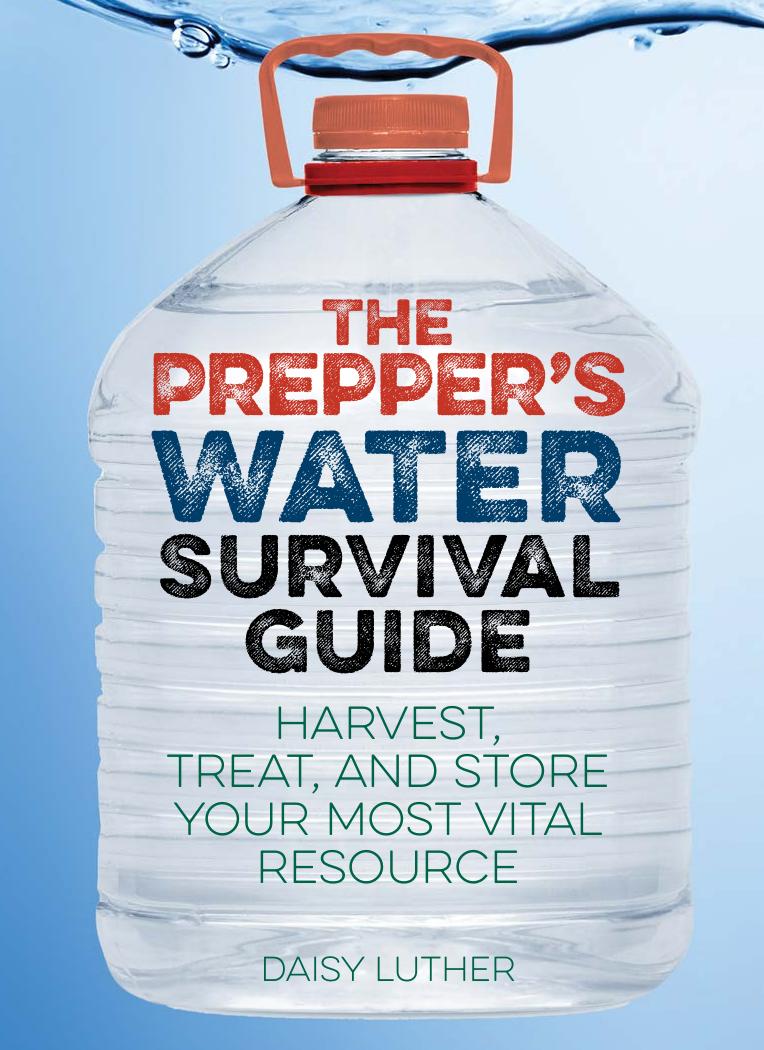The Prepper's Water Survival Guide by Daisy Luther

Author:Daisy Luther [Luther, Daisy]
Language: eng
Format: epub, pdf
ISBN: 9781612434643
Publisher: Ulysses Press
Rainwater
If your property doesn’t have any bodies of water nearby, you can use a catchment system for rainwater. This is the ultimate DIY water source. If you’re lucky enough to live in a place with substantial rainfall, even if you’re in the middle of a city with no other natural sources, you’ve got it made.
Rainwater has long been valued for its purity and softness. It has a nearly neutral pH and is free from disinfection byproducts, salts, minerals, and other natural and man-made contaminants. Rainwater harvesting is an ancient technique, but its popularity as a renewable, sustainable, and high-quality source of water has been increasing in recent years.
Most rainwater is pure until it comes in contact with surfaces that are not. However, if you live in an area that produces heavy industrial pollution, your rainwater may contain some undesirable contaminants. You can find out if this is a risk by contacting your local municipal government before you set up a harvesting system.
If you get frequent precipitation throughout the year, numerous water butts or barrels at the corners of your structures may supply enough water for your needs, including supplementing your garden. (Be warned that the “eco-police” in some places believe that the government owns the water falling from the sky; rainwater catchment is actually illegal in some states.)
Rainwater harvesting may not seem like it would yield much, but you’d be surprised: According to some estimates, for every inch of rain that falls on a catchment area of 1,000 square feet, you can expect to collect approximately 600 gallons of rainwater. Ten inches of rain falling on a 1,000-square-foot catchment area will generate about 6,000 gallons of rainwater—6,000 gallons! If you think you are one of the lucky people who will be able to collect that much (or more), be sure you have large cisterns or other vessels ready.
Don’t let the thought of having to do calculations deter you. Setting up a rainwater collection and storage system is fairly easy, and there are various ways to do it.
First, you’ll need to find areas around your homestead where you can collect water. You can collect runoff from anywhere the rain doesn’t soak into the ground. This can mean the roof of your home or any other structures on your property.
Keep in mind that any catchment area is going to catch a lot more than water. Leaves, twigs, animal droppings, and other natural debris will likely get mixed in with your water. As with any water you are going to use for consumption, you’ll need to filter it before drinking it.
There are some types of roofs that are not recommended for water-harvesting catchments because the risk of contamination is too high. Old tar and gravel roofs and those made with asbestos shingles or treated cedar are some examples.
So, if you don’t know what materials your roof is made of, it is important to find out prior to using it as a catchment system.
You’ll also need to know what your gutters are composed of.
Download
The Prepper's Water Survival Guide by Daisy Luther.pdf
This site does not store any files on its server. We only index and link to content provided by other sites. Please contact the content providers to delete copyright contents if any and email us, we'll remove relevant links or contents immediately.
| Acoustics | Bridges |
| Earthwork Design | Environmental |
| Fire Science | Highway & Traffic |
| Hydrology | Remote Sensing |
| Seismic Design | Structural |
| Structural Dynamics | Surveying & Photogrammetry |
| Transportation |
Whiskies Galore by Ian Buxton(40288)
Introduction to Aircraft Design (Cambridge Aerospace Series) by John P. Fielding(32327)
Small Unmanned Fixed-wing Aircraft Design by Andrew J. Keane Andras Sobester James P. Scanlan & András Sóbester & James P. Scanlan(32134)
Craft Beer for the Homebrewer by Michael Agnew(17439)
Turbulence by E. J. Noyes(7031)
The Complete Stick Figure Physics Tutorials by Allen Sarah(6629)
Kaplan MCAT General Chemistry Review by Kaplan(6044)
The Thirst by Nesbo Jo(5777)
Bad Blood by John Carreyrou(5760)
Learning SQL by Alan Beaulieu(5398)
Weapons of Math Destruction by Cathy O'Neil(5027)
Man-made Catastrophes and Risk Information Concealment by Dmitry Chernov & Didier Sornette(4727)
iGen by Jean M. Twenge(4692)
Digital Minimalism by Cal Newport;(4504)
Life 3.0: Being Human in the Age of Artificial Intelligence by Tegmark Max(4491)
Audition by Ryu Murakami(4090)
1,001 ASVAB Practice Questions For Dummies by Powers Rod(4034)
Electronic Devices & Circuits by Jacob Millman & Christos C. Halkias(4018)
Pale Blue Dot by Carl Sagan(3995)
